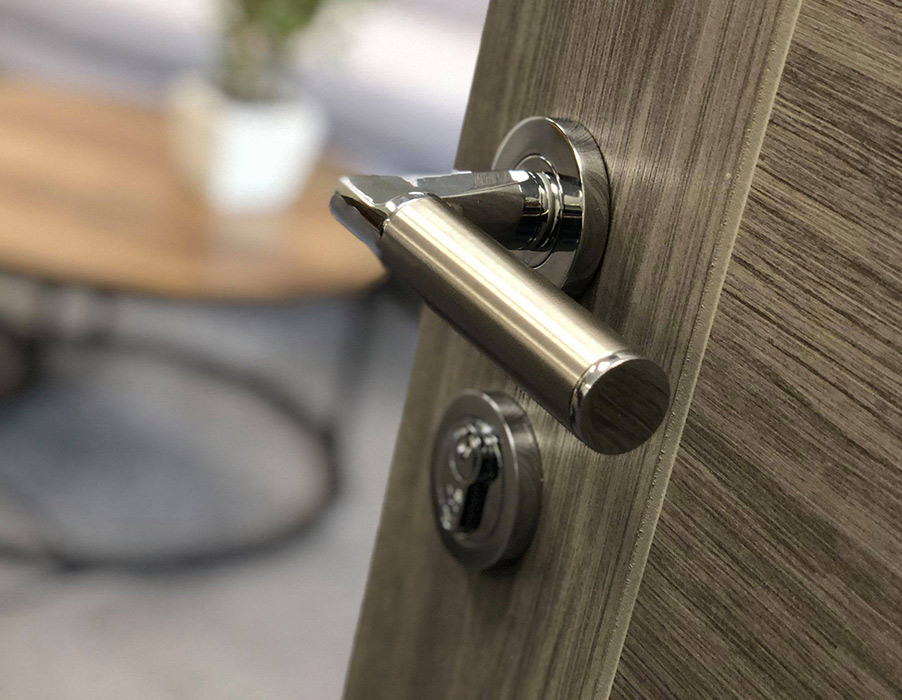If you feel like your doors need a little makeover so that they are looking their best, you don’t need to change or replace the whole door to achieve a new look. Just by updating the door handles you can easily improve the look of your existing doors and can make a big difference to the overall appearance of your home.
Replacing your door Handles is a cost-effective, quick, and easy DIY project that will help you to update the look of your doors. As well as being a necessity door handles can also be a way to add some style or uniformity to your decor. So if you are currently renovating, or want to update your doors with new modern door handles just follow our step-by-step instructions below.

What Type of Door Handle To Choose?
There are thousands of door handle types to choose from. From Sliding door handles,to kitchen door handles and bolt through door handles. You first need to choose a door handle that will work for the type of door you have. Check out our handy guide on types of door handles.
Next comes the more interesting part of choosing the design, material and finish of your door handle. Some of our most popular door handles include the Satin PVD Brass Crown Knurled Lever on Rose. Or for a more traditional look the Carlisle Brass Polished Chrome Victorian Lever on Latch Backplate. The Antique Brass 158mm Knurled Pull Handle is a popular choice for pull handles and you can’t go wrong with a matt black snib and release handle.

Replacing Your Door Handle
You Will Need
- Pencil / Pen
- Hammer
- Screwdriver with various heads
- Wood Chisel
- Tape measure
- Drill
- Spade bit
- Drill bits
- Set square
- Dust Sheets
- Tape
- Door handle kit
- Door wedges
- Latch
Firstly, make sure you have all your equipment in hand. Prepare the area by placing down your dust sheets and using your door wedges to secure the door.
Replacing An Existing Door Handle
As you are replacing existing door handles you will need to remove the old ones first.
- To do this you need to remove the screws holding the handle in place. These will usually be on the cover plate. However, some knob and handle designs will need to have screws removed from both sides of the door.
- Next you need to find the slot along one edge of the plate. Insert the screwdriver into the slot and twist it to pop off the plate. Remove the screws from under the plate, and then unscrew and slide out the old latch.
- Finally, unscrew the strike plate from the door frame.
Fitting Your New Door Handle
TIP: Most door handles come with a kit and provide a measurement template for you to follow.
- The backset is the distance from the centre of the big hole on the front surface of the door to the edge of the door. Measure it to check that your chosen replacement handle or knob will work with your existing backset.
- Slide the new latch into the edge of the door, and then screw it in place by hand, then tighten it with a drill. Insert half of the knob or handle with the peg into the door first, insert the peg into the latch mechanism, then push on the other half of the knob or handle, and then screw it in place.
- If any holes or marks from the previous door furniture are visible, sand them and fill them with wood putty, then touch them up with paint if necessary. Finally, screw the new strike plate to the door frame.
We hope these instructions will help to safely guide you on how to fit your door handle. If you have any enquiries about our ironmongery products, please call our team on 01376 557 561 or email info@ironmongeryexperts.co.uk.

Disclaimer
At Kingwaych Experts we strongly advise that you always take safety precautions into consideration when undertaking a DIY project. We also strongly suggest that you closely read and follow the instructions provided by the manufacturer of any building materials, products or tools you use for your projects.
We try our best to provide clear and correct instructions within our articles, so you can easily complete any DIY project you desire. However, please note that the information we provide should only be used as a guideline and that some information within the text may not be entirely accurate.
When using our articles for information and advice, please note that is your own responsibility to determine your capabilities when undertaking and executing the task you wish to complete.
Before starting a DIY task, we strongly recommend that you educate yourself of any existing building, gas, water and electrical works regulations. We believe it is in your best interest to complete further research and/or contact the necessary professional body should you have any further concerns.
We also strongly recommend that a qualified tradesperson completes the relevant safety tests and checks on any DIY you have completed.